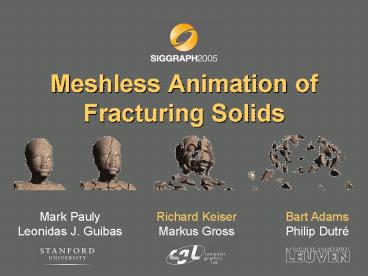Meshless Animation of Fracturing Solids PowerPoint PPT Presentation
1 / 37
Title: Meshless Animation of Fracturing Solids
1
Meshless Animation of Fracturing Solids
Richard Keiser Markus Gross
2
Motivation
- Simulation of fracturing materials in many
different applications.
3
Motivation
- Simulation of fracturing materials in many
different applications. - Requirements on fracturing algorithm
4
Motivation
- Simulation of fracturing materials in many
different applications. - Requirements on fracturing algorithm
- brittle or ductile fracture
5
Motivation
- Simulation of fracturing materials in many
different applications. - Requirements on fracturing algorithm
- brittle or ductile fracture
- arbitrary cracks
6
Motivation
- Simulation of fracturing materials in many
different applications. - Requirements on fracturing algorithm
- brittle or ductile fracture
- arbitrary cracks
- control of fracture paths
7
Motivation
- Simulation of fracturing materials in many
different applications. - Requirements on fracturing algorithm
- brittle or ductile fracture
- arbitrary cracks
- control of fracture paths
- highly detailed surfaces
8
Related Work
- OBrien Hodgins 99, 02
- dynamic remeshing
- element cutting
- difficult to avoid ill-shaped elements
9
Related Work
- OBrien Hodgins 99, 02
- dynamic remeshing
- element cutting
- difficult to avoid ill-shaped elements
- Molino, Bao Fedkiw 04
- virtual node algorithm
- embedded surface in copied tetrahedra
- restricted decomposition of tetrahedras
10
Meshless Methods
- Advantages
- sampling of the volume
- handling of large deformation
- (re-)sampling of the domain
- handling of discontinuities
- Drawbacks
- boundary conditions
- overhead for computing interpolation functions
11
Contributions
- A meshless animation framework for stiff-elastic
and plasto-elastic materials that fracture - handling of brittle and ductile fracture
- allows arbitrary crack initiation and propagation
- allows for easy control
- highly detailed surfaces due to decoupling of
physics and surface representation
12
Overview
- Part 1 Physics Animation
- Meshless Continuum Mechanics
- Modeling Discontinuities
- Spatial Re-sampling
- Part 2 Surface Handling
- Surface Model
- Crack Initiation Propagation
- Topological Events
13
Elasticity Model
- Meshless elasticity model derived from continuum
mechanics.1
Simulation loop
Time integration
Gradient of displacement field
Strain
Stress
Body force
Add external forces
Strain energy
1
Müller et al. Point Based Animation of Elastic,
Plastic and Melting Objects, SCA 2004
14
Discretization
- Discrete set of nodes xi
- Approximation of displacement field u
u(x) ? ?i ?i(x) ui
- Derivation of shape functions
- using Moving Least Squares (MLS)
x
xi
ui
15
Discretization
- Shape functions ?i
?i(x) ?i(x,xi) pT(x) M(x)-1 p(xi)
? by construction they build a first order
partition of unity (PU)
r x-y/hi with hi the support radius of node
i
16
Discontinuities
- Only visible nodes should interact
- collect nearest neighbors
- perform visibility test
crack
17
Discontinuities
- Only visible nodes should interact
- collect nearest neighbors
- perform visibility test
crack
18
Discontinuities
- Problem undesirable discontinuities of the shape
functions - not only along the crack
- but also within the domain
crack
19
Discontinuities
Visibility Criterion
Weight function
Shape function
20
Discontinuities
- Solution transparency method1
- nodes in vicinity of crack partially interact
- by modifying the weight function
crack
ds
?i(xi,xj) ?i(xi-xj/hi (2ds/?)2)
- crack becomes transparent
- near the crack tip
1
Organ et al. Continuous Meshless Approximations
for Nonconvex Bodies by Diffraction and
Transparency, Comp. Mechanics, 1996
21
Discontinuities
Visibility Criterion
Transparency Method
Weight function
Shape function
22
Re-sampling
- Add simulation nodes when number of neighbors too
small
- Local resampling of the domain of a node
- distribute mass
- adapt support radius
- interpolate attributes
xi
Shape functions adapt automatically!
23
Re-sampling Example
24
Part 2Surface Handling
25
Surface Animation
- All surfaces are represented using oriented point
samples si wrapped around the simulation nodes
pj - Deformation of surfels is computed from
neighboring simulation nodes
simulation nodes pj
surfels si
26
Crack Propagation
- Crack initiation
- where stress above threshold
- crack created by inserting 3 crack nodes
- each carrying 2 opposing surfels
- connection is crack front
crack front
27
Crack Propagation
- Crack propagation
- propagate crack nodes along propagation direction
- re-project first and last node
- up-sample if necessary
one fracture surface
28
Crack Propagation Example
29
Crack Events
- Splitting
- when crack propagates through the material
- split front in two new fronts
- each one propagates independently
block of material
30
Crack Events
- Merging
- when two fronts propagate close to each other
- merge fronts and associated fracture surfaces
block of material
31
Crack Events Example
32
Brittle Fracture
Initial statistics 4.3k nodes 249k surfels
Final statistics 6.5k nodes 310k surfels
Simulation time 22 sec/frame
33
Controlled Fracture
Initial statistics 4.6k nodes 49k surfels
Final statistics 5.8k nodes 72k surfels
Simulation time 6 sec/frame
34
Ductile Fracture
Initial statistics 2.2k nodes 134k surfels
Final statistics 3.3k nodes 144k surfels
Simulation time 23 sec/frame
35
Conclusion
- Advantages
- decoupling of physics and surface representation
- dynamic adaptation of shape functions
- during crack propagation
- when re-sampling of spatial domain
- Drawbacks
- excessive fracturing ? simulation nodes ??
- visibility testing is still costly
- each test ray-surface intersection test
36
Future Work
- Real-time simulation
- simplification of algorithms
- efficient data structures
- efficient caching schemes
- Solve excessive up-sampling issue
- variant of the virtual node algorithm
37
Thank you!
- Contact information
- Mark Pauly pauly_at_inf.ethz.ch
- Richard Keiser keiser_at_inf.ethz.ch
- Bart Adams barta_at_cs.kuleuven.ac.be
- Phil Dutré phil_at_cs.kuleuven.ac.be
- Markus Gross grossm_at_inf.ethz.ch
- Leonidas J. Guibas guibas_at_cs.stanford.edu

